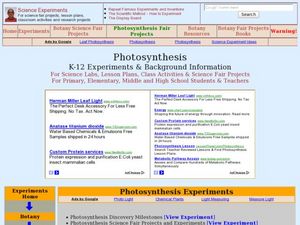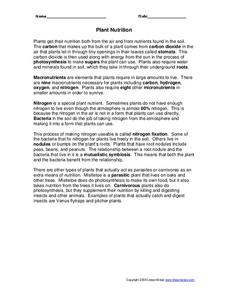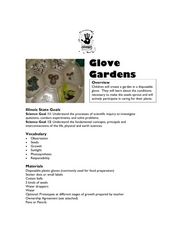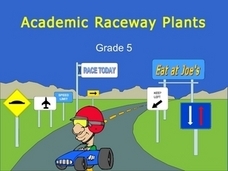Curated OER
Science: Pigments and Photosynthesis
Learners explore the process of photosynthesis by identifying chloroplasts and chlorophyll pigments. In a demonstration, they observe a demonstration connecting pigments with sunlight conversion into energy. Using paper chromatography,...
Curated OER
Ecosystems - Plants and Animals Together
Students study the biotic and abiotic factors of an environment. In this exploratory lesson students examine the different trophic levels and how organisms are connected.
Curated OER
Light - Plant Science Chapter #8
A brief presentation provides notes on light for agriculture pupils. Topics covered are light quality and duration, how resulting temperatures affect crop selection, vernilization, and bolting. Even though this is titled "Light," it...
Curated OER
Sensational Seaweed
Students compare kelp and land plants. In this sea plant lesson, students look at the role of algae in aquatic environments. They research the properties of kelp and explore seaweed.
American Chemical Society
Isolation of Phytochrome
Why do soybean plants that are planted weeks apart in the spring mature simultaneously in the fall? Four independent activities cover the history of phytochrome research, scientist collaboration, the electromagnetic spectrum, and...
Virginia Department of Education
Cell Parts
What do a bird, an egg, a rabbit, and a toad all have in common? This fun-filled resource explains the similarities and differences between cells and how all cells are similar, yet all are different. Learners begin by depicting a...
Curated OER
Prairie Math
Students work together to build models of prairie plants. Using the model, they estimate the height and then measure them using metric and standard units. They write a fraction to represent their part of the whole set and compare and...
Curated OER
Photosynthesis
High schoolers explore the concept of photosynthesis. They describe the light and light independent reactions of photosynthesis. Students relate physical plant characteristics to their functions. They distinguish between C3, C4, and CAM...
Curated OER
Unit on Developing a Basic Understanding of Plants
Fifth graders study the parts of a plant, their life cycles, and how to care for them in this unit.
Curated OER
Breathe In, Breath Out
Students discover how plants breathe. For this biology lesson plan, students learn that plants take in carbon dioxide and find that plants need sunlight to absorb the carbon dioxide.
Curated OER
Energy Flow - How Much Biomass do Plants Produce?
Students explore the concept of biomass. For this plant lesson, students conduct a scientific investigation that requires them to observe plant growth and biomass.
Curated OER
Plant Nutrition
In this plant nutrition worksheet, learners read for information and assess comprehension. In this true and false, fill in the blank, multiple choice, and short answer worksheet, students answer ten questions.
Curated OER
An Environmental Puzzle: The Carbon Cycle
Middle schoolers are introducced to how respiration and photosysnthesis cycle carbon through ecosystems. They read background information that describes the role of the Sun as Earth's ultimate energy source and explains how the energy...
Curated OER
Ecology 5 - Carbon and Oxygen Cycles
Students construct their own diagrams outlining the pathway of carbon and oxygen in our atmosphere. They listen to a lecture on the carbon cycle while drawing an example of the carbon cycle on the board. Students comprehend that CO2 is...
Curated OER
Carbon Cycle Game
In this carbon cycle lesson, middle schoolers review the carbon cycle and visit stations in the room where they experience every phase in the carbon cycle. Students journal about their journey through the cycle and brainstorm ways...
Curated OER
Rice Farming
Third graders investigate how farmers get more rice from their land. In this farming lesson plan, 3rd graders discover things that farmers to do produce more rice. Students study photosynthesis and illustrate pictures about it. Students...
Curated OER
Glove Gardens
Students investigate how seeds sprout. In this scientific inquiry lesson, students make predictions on which seeds will grow the fastest and observe the seeds over a period of time. Observations are recorded into a journal.
Curated OER
How about a Little Give and Take?
Students design a closed system to test the relationships between plants and animals. They monitor abiotic fluctuations within this living system by using a chemical test kit. They observe how living organisms respond to fluctuations in...
Curated OER
Design a Reef!
Students explore coral reef ecosystems. In this ecosystems science instructional activity, students research coral reef ecosystems to determine the major functions the participating organisms must perform. Students construct...
Curated OER
Fayettewood Squares
If used as a center activity, this short presentation could be a motivating way for learners to review material relating to plants, the circulatory system, and more. However, there are only nine questions. It would be more useful if...
Curated OER
Jeopardy 8th Grade (Science)
There are so many topics touched upon in this Jeopardy-style science game, that it is difficult to classify! The categories include electricity, matter, ecology, earth and space, and scientific investigation. This would best be used at...
Curated OER
All About Plants
Young scholars identify plant needs. In this biology lesson, students watch All About Plants and then write a paragraph describing the various details about plants.
Curated OER
Photosynthesis and Respiration
In this photosynthesis worksheet, 7th graders study the effects of photosynthesis and respiration in plants and animals. Students respond to 21 short answer questions.
Curated OER
Academic Raceway: Plants Grade 5
This plants PowerPoint provides plant part vocabulary words and the related definitions. The Academic Raceway interactive questions are not included.

























